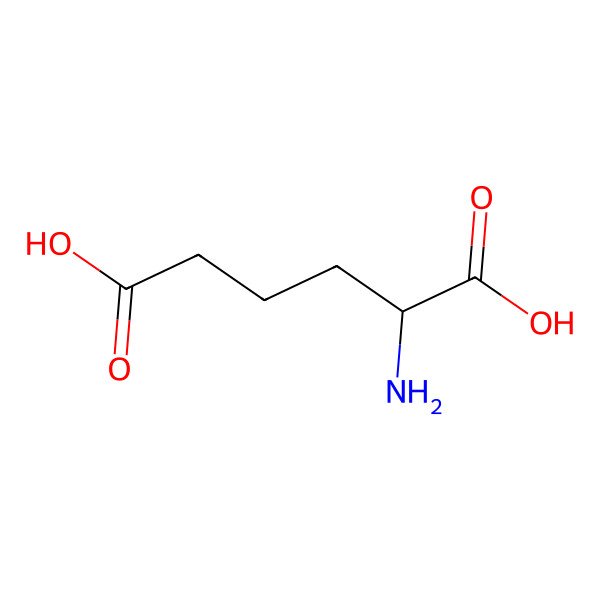2-Aminohexanedioic acid
| Internal ID | b41a4eb0-94cd-46c7-b649-e7eb1a7606a7 |
| Taxonomy | Organic acids and derivatives > Carboxylic acids and derivatives > Amino acids, peptides, and analogues > Alpha amino acids and derivatives > Alpha amino acids |
| IUPAC Name | 2-aminohexanedioic acid |
| SMILES (Canonical) | C(CC(C(=O)O)N)CC(=O)O |
| SMILES (Isomeric) | C(CC(C(=O)O)N)CC(=O)O |
| InChI | InChI=1S/C6H11NO4/c7-4(6(10)11)2-1-3-5(8)9/h4H,1-3,7H2,(H,8,9)(H,10,11) |
| InChI Key | OYIFNHCXNCRBQI-UHFFFAOYSA-N |
| Popularity | 1,445 references in papers |
| Molecular Formula | C6H11NO4 |
| Molecular Weight | 161.16 g/mol |
| Exact Mass | 161.06880783 g/mol |
| Topological Polar Surface Area (TPSA) | 101.00 Ų |
| XlogP | -3.10 |
| 542-32-5 |
| DL-2-Aminoadipic acid |
| 2-AMINOADIPIC ACID |
| aminoadipic acid |
| alpha-Aminoadipic acid |
| DL-alpha-Aminoadipic acid |
| 2-Aminoadipate |
| DL-2-Aminohexanedioic acid |
| Hexanedioic acid, 2-amino- |
| 2-amino-hexanedioic acid |
| There are more than 10 synonyms. If you wish to see them all click here. |

| Target | Value | Probability (raw) | Probability (%) |
|---|---|---|---|
| No predicted properties yet! | |||
Proven Targets:
| CHEMBL ID | UniProt ID | Name | Min activity | Assay type | Source |
|---|---|---|---|---|---|
| CHEMBL1293237 | P54132 | Bloom syndrome protein |
15.8 nM |
Potency |
via Super-PRED
|
| CHEMBL1963 | P16473 | Thyroid stimulating hormone receptor |
79.4 nM |
Potency |
via Super-PRED
|
Predicted Targets (via Super-PRED):
| CHEMBL ID | UniProt ID | Name | Probability | Model accuracy |
|---|---|---|---|---|
| CHEMBL3251 | P19838 | Nuclear factor NF-kappa-B p105 subunit | 96.15% | 96.09% |
| CHEMBL3060 | Q9Y345 | Glycine transporter 2 | 93.02% | 99.17% |
| CHEMBL236 | P41143 | Delta opioid receptor | 89.49% | 99.35% |
| CHEMBL5285 | Q99683 | Mitogen-activated protein kinase kinase kinase 5 | 88.84% | 92.26% |
| CHEMBL3976 | Q9UHL4 | Dipeptidyl peptidase II | 88.33% | 92.29% |
| CHEMBL4793 | Q86TI2 | Dipeptidyl peptidase IX | 87.11% | 96.95% |
| CHEMBL2581 | P07339 | Cathepsin D | 87.10% | 98.95% |
| CHEMBL1255126 | O15151 | Protein Mdm4 | 84.09% | 90.20% |
| CHEMBL4040 | P28482 | MAP kinase ERK2 | 83.99% | 83.82% |
| CHEMBL221 | P23219 | Cyclooxygenase-1 | 83.78% | 90.17% |
| CHEMBL4657 | Q6V1X1 | Dipeptidyl peptidase VIII | 82.79% | 97.21% |
| CHEMBL2514 | O95665 | Neurotensin receptor 2 | 82.48% | 100.00% |
| CHEMBL1907591 | P30926 | Neuronal acetylcholine receptor; alpha4/beta4 | 81.88% | 100.00% |
| CHEMBL3230 | O95977 | Sphingosine 1-phosphate receptor Edg-6 | 81.78% | 94.01% |
| CHEMBL3359 | P21462 | Formyl peptide receptor 1 | 81.70% | 93.56% |
| CHEMBL5619 | P27695 | DNA-(apurinic or apyrimidinic site) lyase | 80.90% | 91.11% |
Below are displayed all the plants proven (via scientific papers) to contain this
compound!
To see more specific details click the taxa you are interested in.
To see more specific details click the taxa you are interested in.
| Caylusea abyssinica |
| Cycas revoluta |
| Cycas rumphii |
| Lathyrus sativus |
| Medicago sativa |
| Prunus domestica |
| Psophocarpus tetragonolobus |
| Vigna radiata |
| PubChem | 469 |
| NPASS | NPC279661 |
| ChEMBL | CHEMBL433238 |
| LOTUS | LTS0221318 |
| wikiData | Q2823204 |